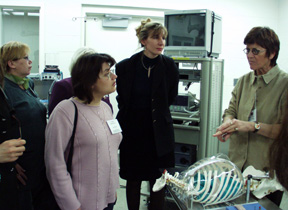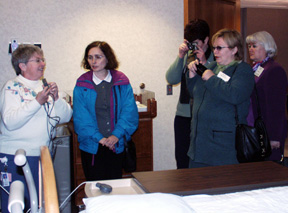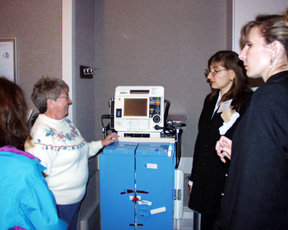 |
Sheila Ryan, Ph.D., far right, UNMC College of Nursing professor and Charlotte Peck Lienemann & Alumni Distinguished Chair, explains to Russian nurse leaders how robotic surgery works. |
Although “da” (yes) and “nyet” were some of the only Russian words spoken between the Americans and Russians without a translator, they quickly became friends.
The UNMC College of Nursing hosted an educational visit of eight Russian nurse leaders Oct. 17-22, in an effort to show their colleagues how health policy efforts can improve the health of their communities. The visiting Russian women were chief nursing officers, managers and professors.
One of five U.S. host sites
Nebraska was one of five sites in the United States to host a total of 40 Russian nurse leaders. The Russians came to Nebraska from Samara in the Oblast region about 1,000 kilometers (about 600 miles) southeast of Moscow. Samara is ranked third in terms of economic development.
The visit was part of the Open World Program of the Center for Russian Leadership Development, U.S. Library of Congress. The purpose of the visit was to educate the nurse leaders in order to help Russian communities provide comprehensive, accessible healthcare services to its citizens.
 |
Cheryl West, far left, assistant professor, UNMC College of Nursing, describes some of the technology used for mothers in labor, to Russian nurse leaders who visited the Nebraska Health System’s Baby Place on the UNMC campus. |
Although Russians are free to do many things since the collapse of socialism in 1989, the visiting nurses said their country is in a state of chaos.
The agenda was full for the six Russian women who spent time in Omaha and the two who spent time in Kearney. With the help of translators, they learned how civic, professional and health service organizations can mobilize and influence health policy to better fund health programs in communities. They also learned about nursing leadership, education and practice, and toured a variety of health care facilities and indulged in American culture.
Sheila Ryan, Ph.D. professor and Charlotte Peck Lienemann & Alumni Distinguished Chair, spearheaded the visit as a board member of the American International Healthcare Alliance. She organized the Omaha visit, while Kate Nickel, Ph.D., assistant professor, UNMC College of Nursing Kearney Division, organized the Kearney visit. Drs. Ryan, Nickel, and other volunteers, opened their homes to the women, as well.
Valuable experience
The Russian nurse leaders said their time in the United States was valuable and they would return with many ideas about how they can help their community.
 |
Cheryl West, far left, assistant professor, UNMC College of Nursing, describes the use of a “crash cart” to Russian nurse leaders in the Nebraska Health System’s Baby Place on the UNMC campus. |
“We’ve seen a lot of many useful things, excellent things, but we have economic problems you don’t have here,” said Valentina Trunova, vice president of Samara Oblast Nurses’ Association and deputy chief physician on nursing, Samara-Polyclinic #2. “Our American colleagues here are highly skilled, qualified individuals just as in Russia, however, the working conditions are totally different. The one thing I’ve observed is the partnership — the teamwork between doctors and nurses.”
“Nurses are trusted — they work more independently (here),” said Natalya Muromskaya, chief nurse, City Hospital #2 and chief nursing specialist of Togliatti city. “A couple of days ago, I had an eye infection. A nurse practitioner came to see me, made the diagnosis herself and suggested treatment and wrote a prescription — all of this without the doctor’s permission. It’s unthinkable in Russia.”
“In Russia, it’s the doctors that mostly do the teaching to nurses,” said Elena Kuznetsova, head nurse medical, Sanitary Unit #5.
Dr. Ryan: “We have been there”
Many of the Russian visitors were stunned to learn what nurse practitioner students are learning, Dr. Ryan said. In addition, learning about community health nursing and health promotion was new to them.
“All the things we went through 20 or 30 years ago is where they are now in nursing,” Dr. Ryan said. “When they ask a question, we know where they’re coming from. We have been there.”
“We are trying to teach them how to use their associations and how politics can influence the improvement of health and the nursing profession,” she said. “Many of them have only recently organized professional associations.”
Differences in the professions
In Russia, nursing salaries are low ($100 a month) and the physician-to-nurse ratio is about five to one, whereas in the United States, it’s four nurses to one physician. Both countries declare a nursing shortage. Almost all the nursing professors in Russia are male physicians.
Although Russians are entitled to free health care, those who want to choose their own physician or want additional services not covered by the government, must pay for them. Some employers supplement health insurance costs for their employees.
“I was impressed”
As they toured health facilities, many things impressed the Russian women. They saw syringes used with retractable needles that prevent accidental needle punctures and were surprised to learn that some syringes are prepared with medication ahead of time by pharmacists. The United States moved toward pre-packaged medications decades ago to prevent medication errors and save time for the nurses who once prepared syringes with medication.
“I was impressed by the distance learning nursing programs, not typical for us,” said Nadezhda Shakirzyanova, chief nurse of the Sergievsk Central Regional Hospital, who spent time in Kearney. “Nursing work is almost always focused on patient care in the U.S., not other ancillary things like transporting patients, cleaning patient rooms, etcetera, as in Russia.”
Peggy Wilson, Ph.D., associate professor and associate dean for graduate programs, UNMC College of Nursing, said while describing what she does as a pediatric nurse practitioner, one Russian woman asked, ‘If you do all of these things, what does the doctor do?’ ”
People made lasting impression
Although the women’s first impression of the United States was one of spaciousness, clean cities and neighborhoods, it is the people that will make a lasting impression.
“We like the people most of all,” Muromskaya said. “Everyone’s very hospitable. They are taking great care of us, just like parents. There’s a language barrier but we’re understanding each other.”
Dr. Nickel said hosting the Kearney visit was personally enriching. “I now not only know how to say several things in Russian, but also learned what it is like to communicate with someone who does not speak your language. It was fun, and yes, at times, frustrating to try to get a point across,” she said.
Forging a bond
Though the women may never see each other again, they now are comrades through an Omaha connection and plan to keep in touch through e-mail. Dr. Ryan said the nurse leaders were enthusiastic when they learned about the online educational program between the college and Armenian nurses. She would like to find funds to establish such a program in Russia.
“The Internet makes it such a smaller world,” Dr. Ryan said. “We’ll continue to communicate with them. This is a way for a global community to be built on mutual respect, commonality and sharing. That will build bridges.”